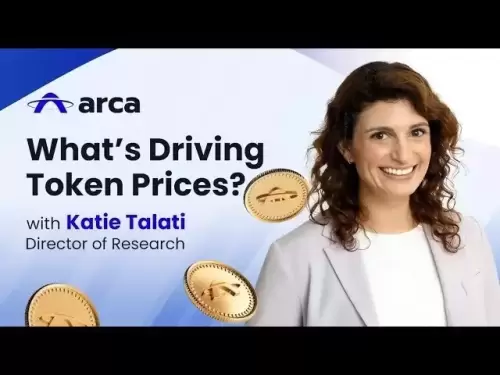-
 Bitcoin
Bitcoin $107,275.1551
-0.32% -
 Ethereum
Ethereum $2,485.3056
1.77% -
 Tether USDt
Tether USDt $1.0005
0.03% -
 XRP
XRP $2.2223
1.31% -
 BNB
BNB $657.7608
1.39% -
 Solana
Solana $156.3566
3.02% -
 USDC
USDC $0.9999
0.01% -
 TRON
TRON $0.2791
1.09% -
 Dogecoin
Dogecoin $0.1651
0.45% -
 Cardano
Cardano $0.5738
2.78% -
 Hyperliquid
Hyperliquid $40.2672
5.82% -
 Bitcoin Cash
Bitcoin Cash $517.5487
5.30% -
 Sui
Sui $2.7981
-0.40% -
 Chainlink
Chainlink $13.3500
-0.36% -
 UNUS SED LEO
UNUS SED LEO $9.1220
1.12% -
 Avalanche
Avalanche $17.9515
-0.32% -
 Stellar
Stellar $0.2361
-0.44% -
 Toncoin
Toncoin $2.9423
2.33% -
 Shiba Inu
Shiba Inu $0.0...01145
-0.68% -
 Litecoin
Litecoin $86.1693
-0.63% -
 Hedera
Hedera $0.1493
0.64% -
 Monero
Monero $315.1374
1.81% -
 Polkadot
Polkadot $3.4002
-0.73% -
 Dai
Dai $1.0001
0.03% -
 Bitget Token
Bitget Token $4.5413
-1.35% -
 Ethena USDe
Ethena USDe $1.0002
-0.01% -
 Uniswap
Uniswap $7.1733
-0.57% -
 Aave
Aave $274.0465
-0.23% -
 Pepe
Pepe $0.0...09810
2.24% -
 Pi
Pi $0.5101
-3.10%
USD and USDT: What is the difference between them?
USD, a government-backed fiat currency, contrasts sharply with USDT, a cryptocurrency pegged to the dollar but subject to fluctuations and transparency concerns regarding its reserves.
Mar 14, 2025 at 02:01 am
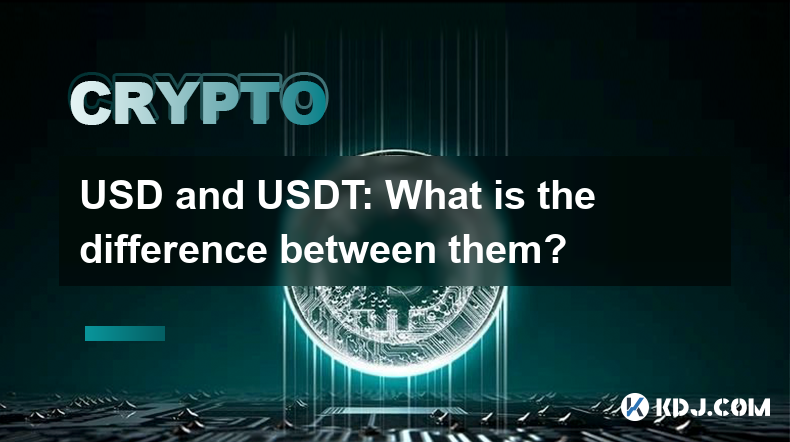
Key Points:
- USD represents the United States Dollar, a fiat currency issued and backed by the U.S. government.
- USDT is a cryptocurrency, a stablecoin pegged to the US dollar. This means it aims to maintain a 1:1 ratio with the USD.
- The key difference lies in their underlying nature: one is a government-backed fiat currency, the other a crypto asset.
- USD transactions occur through traditional banking systems, while USDT transactions happen on blockchain networks.
- USDT's value fluctuates slightly around $1, unlike the relatively stable value of the USD. However, significant deviations raise concerns.
USD and USDT: Understanding the Distinctions
The United States Dollar (USD) and Tether (USDT) are often mentioned together in cryptocurrency discussions, but they represent fundamentally different entities. Understanding their differences is crucial for anyone navigating the crypto landscape.
The USD is the official currency of the United States, a fiat currency whose value is determined by market forces and government policies. Its value is relatively stable compared to other fiat currencies, although it does experience fluctuations. Transactions involving USD are processed through traditional banking systems, credit card networks, and other established financial institutions. These transactions are typically subject to regulatory oversight.
USDT, on the other hand, is a cryptocurrency, specifically a stablecoin. It’s designed to maintain a 1:1 peg with the USD. This means that one USDT should theoretically always be worth one USD. However, this peg isn't always perfectly maintained. While fluctuations are generally small, any significant deviation from the $1 mark can trigger concern and market volatility. USDT transactions occur on various blockchain networks, offering faster and potentially cheaper international transfers compared to traditional banking. These transactions, while pseudonymous, are recorded on a public ledger.
How are they used differently in the crypto space?
USD's role in the crypto world is primarily as an on-ramp and off-ramp. Users often exchange fiat currency (USD) for cryptocurrencies on exchanges. They may also cash out their crypto holdings back into USD. USD provides a stable reference point for valuing crypto assets.
USDT's use within the cryptocurrency ecosystem is significantly more widespread. It acts as a stable medium of exchange, facilitating trading between different cryptocurrencies without the volatility associated with other crypto assets. Many crypto exchanges use USDT as a pairing currency for trading. This allows traders to manage risk more effectively by avoiding direct exposure to the price swings of volatile cryptocurrencies.
The Mechanics of USDT:
Tether, the company behind USDT, claims to hold reserves of USD (and other assets) equivalent to the number of USDT in circulation. This is meant to maintain the peg. However, the exact nature and verification of these reserves have been a subject of ongoing debate and scrutiny within the crypto community.
Key Differences Summarized:
- Issuance: USD is issued by a central bank (the Federal Reserve), while USDT is issued by a private company (Tether).
- Regulation: USD is subject to extensive government regulation, while USDT's regulation varies depending on jurisdiction.
- Transparency: USD's monetary policy and reserves are generally transparent, while USDT's reserves and operations are less transparent, leading to concerns about its stability.
- Transaction Speed: USD transactions are relatively slow compared to USDT transactions on blockchain networks.
- Volatility: USD is relatively stable compared to USDT, which experiences minor fluctuations around its $1 peg.
How to acquire USD and USDT:
- Acquiring USD: This is typically done through traditional banking channels, such as opening a bank account or obtaining cash.
- Acquiring USDT: This involves purchasing USDT from cryptocurrency exchanges using either fiat currency (like USD) or other cryptocurrencies.
Step-by-Step Guide to Buying USDT (Example):
- Choose a reputable cryptocurrency exchange: Research and select an exchange that supports USDT trading and has a good security record.
- Create an account: Follow the exchange's instructions to create an account and verify your identity.
- Deposit funds: Deposit fiat currency (USD) or other cryptocurrencies into your exchange account.
- Place a buy order: Place a buy order for USDT, specifying the amount you wish to purchase.
- Transfer (optional): Transfer your purchased USDT to a personal crypto wallet for increased security.
Frequently Asked Questions:
Q: Is USDT a safe investment?
A: The safety of USDT is a complex issue. While it aims for stability, its peg to the USD isn't guaranteed, and concerns regarding its reserves persist. Risk tolerance varies greatly between investors.
Q: Can USDT be used for everyday purchases?
A: While some merchants accept USDT, its widespread adoption for everyday purchases remains limited compared to USD.
Q: What are the risks associated with USDT?
A: Risks include the potential for de-pegging from the USD, regulatory uncertainty, and counterparty risk associated with Tether as the issuer.
Q: How does USDT differ from other stablecoins?
A: USDT is one of many stablecoins, each with its own mechanism for maintaining its peg and associated risks. Some are backed by different assets, while others employ algorithmic methods.
Q: Is it possible for USDT to lose all its value?
A: While unlikely, a complete loss of value is theoretically possible if Tether were to experience a significant crisis or lose its backing. This highlights the inherent risks associated with stablecoins.
Disclaimer:info@kdj.com
The information provided is not trading advice. kdj.com does not assume any responsibility for any investments made based on the information provided in this article. Cryptocurrencies are highly volatile and it is highly recommended that you invest with caution after thorough research!
If you believe that the content used on this website infringes your copyright, please contact us immediately (info@kdj.com) and we will delete it promptly.
- OKX and Binance Delist Trading Pairs: What's Going On?
- 2025-07-01 02:30:12
- Pepeto vs. Shiba Inu: Can the New Meme Coin Dethrone the King?
- 2025-07-01 02:50:11
- Saylor, Bitcoin, Holdings: Strategy's Crypto Empire Grows
- 2025-07-01 02:30:12
- Coinbase, Altcoins, and Listings: What's the Buzz?
- 2025-07-01 00:30:11
- Chainlink's Bullish Signals: Investors Bet on Long-Term Value
- 2025-07-01 00:50:12
- CICADA Finance Soars on BNB Chain: A TGE Deep Dive
- 2025-07-01 01:30:11
Related knowledge

How to choose a reliable USDT exchange service provider? How to identify?
Jun 12,2025 at 03:15pm
Understanding the Role of USDT in Cryptocurrency TradingUSDT (Tether) is one of the most widely used stablecoins in the cryptocurrency market. It is designed to maintain a 1:1 peg with the U.S. dollar, offering traders and investors a way to hedge against volatility while remaining within the crypto ecosystem. Choosing a reliable USDT exchange service p...
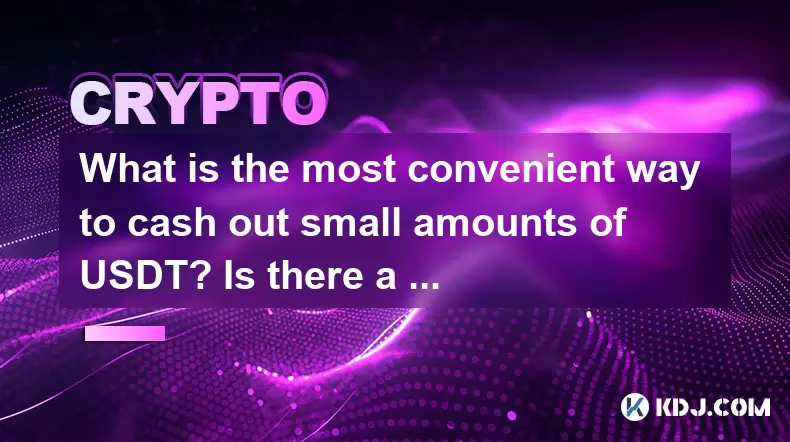
What is the most convenient way to cash out small amounts of USDT? Is there a shortcut?
Jun 11,2025 at 11:00pm
Understanding the Need to Cash Out Small USDT AmountsCashing out small amounts of USDT can be a challenge for many crypto users. Traditional methods often involve high fees, minimum withdrawal limits, or cumbersome verification processes that make it inefficient for small transactions. The key is to find a method that balances speed, cost, and convenien...
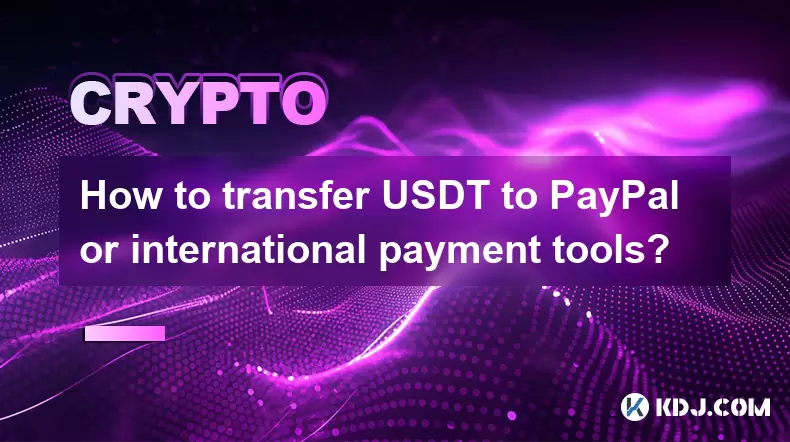
How to transfer USDT to PayPal or international payment tools?
Jun 15,2025 at 05:28am
Understanding the Basics of USDT and PayPal IntegrationUSDT (Tether) is a stablecoin pegged to the US dollar, offering blockchain-based value transfer with minimal volatility. PayPal, on the other hand, is a centralized digital wallet that facilitates fiat currency transactions globally. Direct integration between USDT and PayPal does not exist due to t...
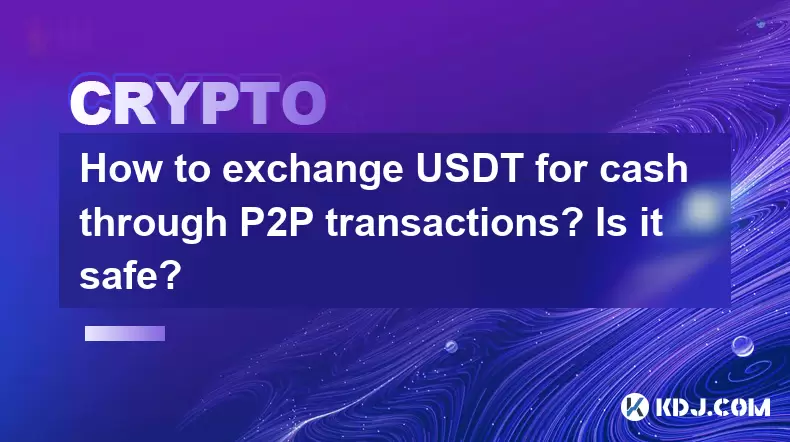
How to exchange USDT for cash through P2P transactions? Is it safe?
Jun 18,2025 at 07:56am
Understanding USDT and P2P TransactionsTether (USDT) is a stablecoin pegged to the value of the US dollar, making it a popular choice for users who want to avoid the volatility of other cryptocurrencies while still participating in the crypto ecosystem. Peer-to-peer (P2P) transactions allow individuals to trade directly with each other without going thr...
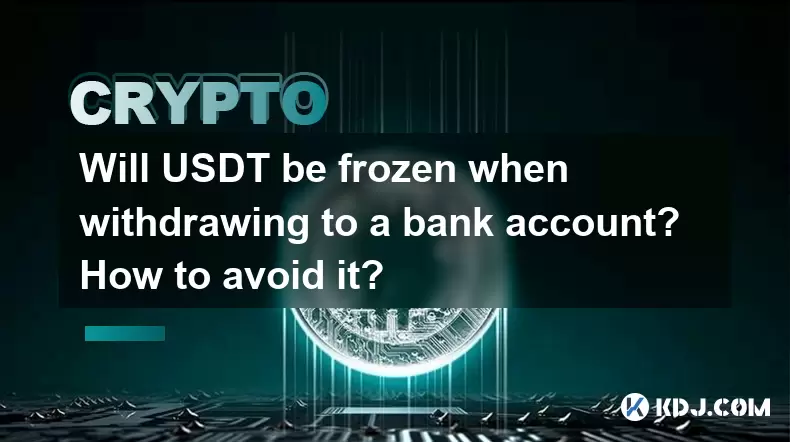
Will USDT be frozen when withdrawing to a bank account? How to avoid it?
Jun 15,2025 at 10:03am
Understanding USDT Withdrawals and Bank Account Freezing RisksWhen users decide to withdraw USDT (Tether) to a bank account, one of the most common concerns is whether their funds will be frozen during the process. This concern stems from real-life cases where individuals have encountered delays or restrictions when converting digital assets into fiat c...

How to avoid risks when exchanging USDT for cash? What are the pitfalls?
Jun 11,2025 at 08:14pm
Understanding the Risks of Exchanging USDT for CashWhen exchanging USDT (Tether) for cash, users must be aware of the potential risks involved. As a stablecoin pegged to the US dollar, USDT is widely used in crypto transactions due to its price stability. However, converting it into fiat currency like USD or CNY can expose users to several pitfalls, inc...

How to choose a reliable USDT exchange service provider? How to identify?
Jun 12,2025 at 03:15pm
Understanding the Role of USDT in Cryptocurrency TradingUSDT (Tether) is one of the most widely used stablecoins in the cryptocurrency market. It is designed to maintain a 1:1 peg with the U.S. dollar, offering traders and investors a way to hedge against volatility while remaining within the crypto ecosystem. Choosing a reliable USDT exchange service p...

What is the most convenient way to cash out small amounts of USDT? Is there a shortcut?
Jun 11,2025 at 11:00pm
Understanding the Need to Cash Out Small USDT AmountsCashing out small amounts of USDT can be a challenge for many crypto users. Traditional methods often involve high fees, minimum withdrawal limits, or cumbersome verification processes that make it inefficient for small transactions. The key is to find a method that balances speed, cost, and convenien...

How to transfer USDT to PayPal or international payment tools?
Jun 15,2025 at 05:28am
Understanding the Basics of USDT and PayPal IntegrationUSDT (Tether) is a stablecoin pegged to the US dollar, offering blockchain-based value transfer with minimal volatility. PayPal, on the other hand, is a centralized digital wallet that facilitates fiat currency transactions globally. Direct integration between USDT and PayPal does not exist due to t...

How to exchange USDT for cash through P2P transactions? Is it safe?
Jun 18,2025 at 07:56am
Understanding USDT and P2P TransactionsTether (USDT) is a stablecoin pegged to the value of the US dollar, making it a popular choice for users who want to avoid the volatility of other cryptocurrencies while still participating in the crypto ecosystem. Peer-to-peer (P2P) transactions allow individuals to trade directly with each other without going thr...

Will USDT be frozen when withdrawing to a bank account? How to avoid it?
Jun 15,2025 at 10:03am
Understanding USDT Withdrawals and Bank Account Freezing RisksWhen users decide to withdraw USDT (Tether) to a bank account, one of the most common concerns is whether their funds will be frozen during the process. This concern stems from real-life cases where individuals have encountered delays or restrictions when converting digital assets into fiat c...

How to avoid risks when exchanging USDT for cash? What are the pitfalls?
Jun 11,2025 at 08:14pm
Understanding the Risks of Exchanging USDT for CashWhen exchanging USDT (Tether) for cash, users must be aware of the potential risks involved. As a stablecoin pegged to the US dollar, USDT is widely used in crypto transactions due to its price stability. However, converting it into fiat currency like USD or CNY can expose users to several pitfalls, inc...
See all articles





















